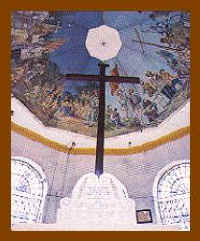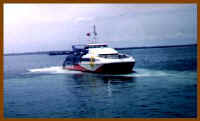On April 8, 1521 Ferdinand Magellan arrived in Cebu and discovered the island
for the Europeans thus opening a route that would be followed by sea traders
until today. Magellan planted a cross in the island that would become
Cebu's most famous landmark. While in the island, Magellan picked a fight with
Cebu's local chieftain Lapu-lapu that led to the now legendary Battle of
Mactan. Magellan was killed in the battle and most of his men were annihilated
by the locals that marked one of histories most stunning war reversals. Spain
was a world power at that time, dividing the world with Portugal, while Cebu
was an unknown remote island in the Pacific.

The remains of Magellan's Cross, now encased and housed in a rotunda in front
of City Hall
Forty-four years later, in February 1565, Spain sent another expedition to
Cebu headed by Miguel Lopez de Legaspi which eventually succeeded in
colonizing Cebu and the central islands of the Visayas as well as the northern
islands of Luzon. The whole archipelago was named "Las Islas
Filipinas" in honor of the then Spanish king Philip II.
Spain ruled the Philippines with an iron fist for 400 years that produced
several rebellions and many Philippine heroes foremost among them was Dr. Jose
Rizal who was recently been accorded as a hero of the Malayan race.
In May 1898 the Americans defeated the Spaniards in the Battle of Manila Bay
and took control of the Philippines. The US Government awarded the Philippines
independence in 1946 but retained favored trade pacts and several U.S.
military bases within the country. In 1991 the Philippine Senate voted against
the continuation of of US Military bases that effectively ended America's
presence in the
Philippines.
Cebu Today
Trying to recapture its old glory, Cebu now leads the Philippines in an
economic upswing unprecedented in its history. It has the fastest growing
economy in the region with an average 19.5% export growth for the past 5
years. Cebu comprises 4% of the country's total population yet accounts for
10% of the country's total exports in 1994. Visit Make it Cebu's business page
for more relevant information.
Cebu is the gateway in central and southern Philippines and is the country's
favorite tourist destination. It is also a jumped-off point for tourists whose
itinerary includes the neighboring islands of the Visayas and Mindanao.
Cebu's Mactan International Airport stands as the best in the country today,
having just completed its P2.6B expansion and modernization program. Cebu
boosts of many world-class hotels and beach resorts and many
more are on the drawing board. In the last 5 years, Golf courses were
mushrooming all over the place.
City Tour
A quick visit to the office of the Department of Tourism isn't a bad idea as
you can get there reference materials about Cebu like city maps, etc. You may
want to start your day by visiting some of the city's most important
landmarks. A three-hour tour within a radius of 20 kms. will transport you
back down Cebu's memory lane where houses, churches and municipal buildings
date back to the first settlements established by the Spaniards in the 16th
century.
You may start your trip at Fort San Pedro, the first Spanish fort built on
Philippine soil, which now houses the Philippine National Museum regional
office. Currently on exhibit is a miniature replica of the San Diego, a 16th
century 300-ton Spanish galleon built in Cebu, which sunk 20 miles south of
Manila de Bay on December 14, 1600 and was only recovered 5 years ago.
The sunken galleon yielded one of the richest finds in history with vast
amount of gold and silverware, ivories, stoneware,
earthenware, porcelains and many other artifacts.
The recovered artifacts are now currently going the rounds in the world's
major capitals.
The Basilica Minore De Santo Nino De Cebu, Santo Nino and a Vendor
outside the Basilica.
From Fort San Pedro, you may walk over to Magallanes (another name of
Magellan) St., where you will find Magellan's cross and just across the street
is the only Catholic Basilica in East Asia -- the Sto. Niño Basilica. It is
the center of devotion and religious pilgrimage throughout the Visayas for it
houses the original deity of the Sto. Niño or the infant Jesus. The deity was
given by Magellan to Queen Juana, the wife of Cebu's King Jumabon.
You may proceed your walk towards Colon St., passing over the shadows of the
old buildings along Osmeña Blvd. Colon St. is the oldest street in the
Philippines and is now a subject of a major restoration effort by the Women's
International League.
A side trip at the famed Carbon Market is highly suggested. The Philippines
being a tropical country, fruits in all shapes and flavors abound the year
over and it is at Carbon Market where most of these fruits first land, so to
speak, after being harvested from Cebu and neighboring islands.
You may then proceed to view the city's different museums and a trek to the
hilly suburbs of the city. Beverly Hills is suggested where the Taoist Temple
rises to a commanding view of the city.
The Taoist Temple High
above the city, The locals Call it the "pawis" temple
(Tagalog for perspiration from climbing the 99 steps)
Another 2-3 hour route brings you to significant historical spots in Lapu-lapu
City and Mactan. From the Mandaue-Mactan Bridge, turn right towards the
market, plaza and Opon Church, the center of local commerce in Mactan Island.
From there you may proceed towards Abuno, Mactan, where many of Cebu's famed
guitar factories are located.
Guitar factories are famous
in Cebu, It is recommended if you are going to bring one home, ask for
an "Export" model. The wood is more appropriate for foreign
climates. The Local Guitars cost from $15. (fifteen dollars) and at $15.
they sound terrific but are a little crude. The Native woods won't
survive in the dryer American Climates. I've heard of some
cracking and splitting and some will crumble and disintegrate with out the
humidity.
You may continue East
towards the resort areas for beachside fun and sightseeing and then end your
trek northwest at the Lapu-lapu shrine at Punta Engla, the spot where the
Battle of Mac tan took place.
Splashing Around
Reprinted from MABUAY! in-flight magazine of the Philippine Airlines
Go footloose in CEBU! On the Philippine map, Cebu is a thin sliver of an
island buffeted all around by clear, unspoiled waters. It's no surprise, then,
that all over the island there are dozens of international-standard beach
resorts where you can swim, snorkel, windsurf or dive. And the best thing
about Cebu is that many of the beaches and resorts are only about an hour's
drive from downtown -- so you can snorkel by day and dress for cocktails at
night.
Mac tan island offers to resort facilities and some of the best diving spots
in the country. Mac tan is a huge coral island that's only a short distance
from the mainland and is equally famous for rope and guitar making. But the
eastern coast is virtual paradise for residents and tourists as well: here you
will find some of the best white beaches in the country, many of which have
been developed as top-rate resorts. Best bets: Shangri-la's Mac tan Island
Resort, Coral Reef, Tumuli, Bluewater, etc. All of these offer adequate
facilities for tourists.
Tucked away in Sogod in the north is the Cebu Club Pacific, a resort far from
the madding crowd and already famous for its nude beach. Down south, try the
Tourist Seaside Hotel in Talisay, which is a short 15-km drive from the city.
Badian Island Resort off the town of Badian is a must-see, as well as Pescador
Island Resort
off the town of Moalboal, a famous coastal town along the southwest end of the
island. Argao Beach Club on the southeastern coast is popular among divers and
windsurfers.
For those who want to rough it up, there are other beach resorts near the
city, including Duawon, Tongo, Aquarius, Beachline, etc., all on the Mactan
east coast. Good beaches can also be found in the coastal towns of Liloan,
Consolacion, Compostela, Danao and Carmen in the north, and in the Talisay
towns of Tanke, Pook and Dumlog.
Already famous as the diving center of the Philippines, Cebu offers excellent
dive sites of up to 150 feet deep, where the spectacular underwater scenery
never fails to leave divers enchanted. Sogod, near the northern tip of the
island, is excellent for cliff diving. So are Buyong in Mactan island, where
night diving is the latest craze, and Sta. Rosa by the Sea. Moalboal is the
diving capital, and Pescador island the place to be. For breathtaking sights
of coral formations and marine life, the coral reefs there, as well as in
nearby Danajon and Caohaga, are a must.
More adventurous divers will proceed further south where Cebu juts out towards
Bohol island. Here the underwater precipices of Panglao and Balicasag and the
Sumilon island marine sanctuary, off the town of Oslob on the southern tip of
the island, offer great views Farther on, Pamilican island offers a rare sight
of huge manta rays during mating rituals.
And the best news of all: Cebu has fine weather all year long!

The "Super Cat" fast ferry to Tagbilaran, about 90 min fare
around $10. Round Trip.
© copyright 1996 by
cebu-online.com.
all rights reserved.
|